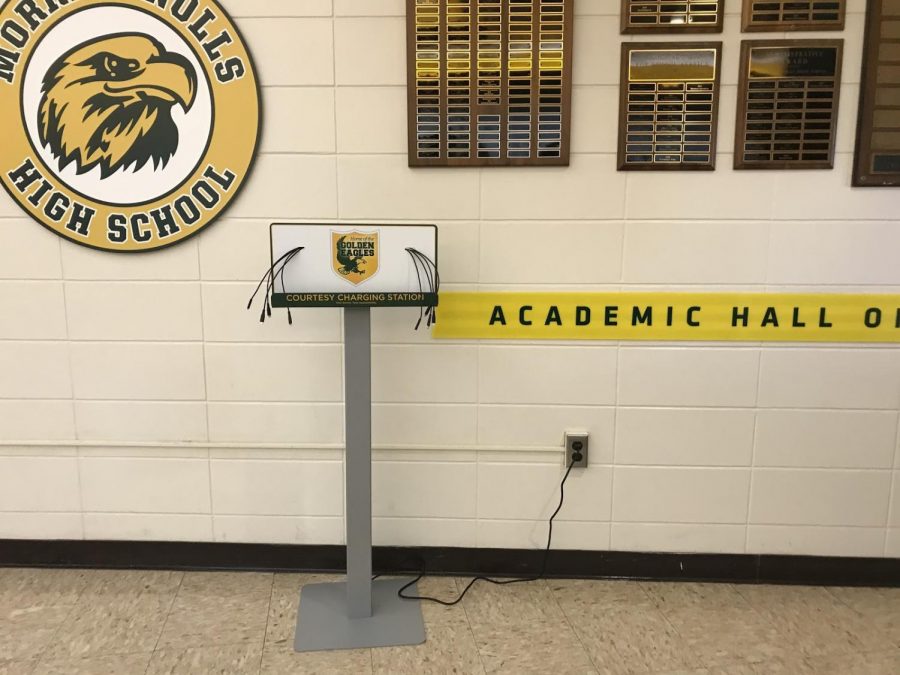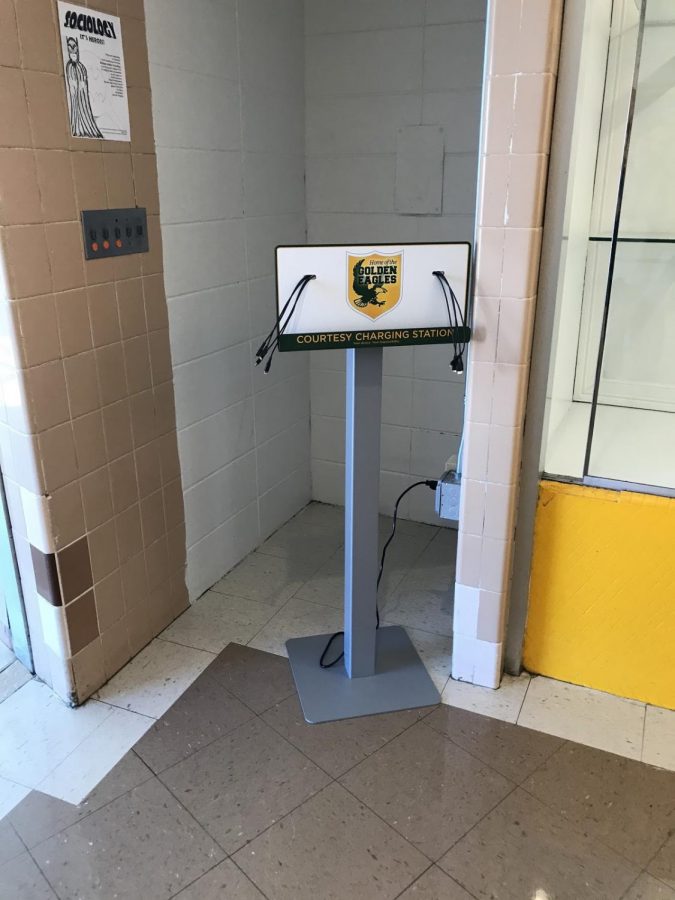Staying Charged
April 21, 2020
Have you noticed the new courtesy charging stations at Morris Knolls? The goal of adding these devices at our school was to give students who rely on random outlets a more convenient way to charge their devices. Being able to keep one’s devices powered is very important, especially because of the increasing role electronics play in today’s world and the desire to lessen the use of paper products in schools.
The charging stands were added over the President Day weekend, which was due to requests from students and faculty members who observed a need for a place to charge multiple devices. Now there are three charging stations throughout the building that every student can use. They are located in the Freshman Y, Senior Y, and the lobby. Some students expressed that since there are few places to sit near the stations located in the Ys, they are not as useful as the one in the lobby. These stations are capable of charging iPhones, Androids, headphones, and even computers and they will hopefully enable students to live in the technological world with more ease.
Today there is a major shift in society, especially with teens, when it comes to use of cell phones and other technologies. A survey conducted by Pew Research Center found that of the teenage participants only 24% stated that they used their cell phone constantly in 2014-2015. This number is almost doubled by 2018 (Anderson 1). Teenagers are using their phones more than ever before which can have both positive and negative outcomes. Overuse of phones can lead to social disconnection as well as lower self esteem if one is on social media too much. There have also been numerous cases of cyberbullying in teens who have unfortunately lead to suicide. However, an author for Stanford Health, Pat Miller, states, “Like any other tool, when used properly, a smartphone can significantly add to someone’s knowledge and enjoyment” (Miller 2). With proper use, a cell phone can be a very useful item for all students, and therefore a cell phone charging station may be beneficial.
Many schools across the US have purchased cell phone charging stations like Morris Knolls. This is because of the value phones have in modern day education. One study showed that 92% of students do last minute studying and 68% of students make last minute changes to their assignments using their smartphone. Clearly, students are using their phones for educational purposes. For example, many students use their phones as a calendar, to keep track of their homework, and as an alarm. Students have to manage their excuriculars, schoolwork, and everything else, so it is necessary for them to always be able to stay on top of these activities. Phones are a convenient way for people to keep track of everything going on in their life. Additionally, due to the increase in school shootings, safety is a pressing problem in schools that phones help address. The ability to call for help wherever you are and whenever you need to is essential. However, if one’s phone dies this aspect of safety is taken away. Clearly, due to the use of phones for schoolwork, planning, and safety, a readily available charger at schools is advantageous.
The new stands could also be beneficial for the environment if schools pair their increased use of technology with decreasing their use of paper. An average school uses 250,000 pieces of paper every year. This leads to drastic deforestation. In one year logging in the U.S., much of which was done to create paper products, accounted for land loss the size of New Jersey. Paper usage also creates carbon admissions. Having constant access to technology due to a charger station could help reduce paper needs. If the new charging station is tied to a more conservative use of paper than Morris Knolls may be able to reduce its negative impact on the environment.
Evidently, the undeniable shift towards technology in society and the need for a reduction of humans’ toll on the environment reveals that a charging station at Morris Knolls has the potential to create a huge impact.
Work Cited
Anderson, Monica. “Teens, Social Media & Technology 2018.” Pew Research Center, 2018, publicservicesalliance.org/wp-content/uploads/2018/06/Teens-Social-Media-Technology-2018-PEW.pdf.
Butler, Rhett. “The Impact of Paper on Rainforests.” Mongabay.com, 9 June 1999, rainforests.mongabay.com/0807a.htm.
“Changing Paper Consumption.” Green Schools Initiative : Changing Paper Consumption, www.greenschools.net/article.php-id=75.html.
“How Much Paper Does the Average School Use?” Reference, IAC Publishing, www.reference.com/world-view/much-paper-average-school-use-c2841c831c1f5915.
Miller, Pat. “Smartphone Impacts on Teenagers: Positive and Negative.” Sanford Health News, 25 Nov. 2019, news.sanfordhealth.org/childrens/smartphone-impacts-on-teens/.
Nathan. “Phone Charging Stations for Colleges, Schools and Universities.” ChargeTech, ChargeTech, 13 Dec. 2019, chargetech.com/education/.
Neal, James. “Charging Stations For Schools & Colleges: The Safe Choice.” GrowCharge, 19 May 2019, growcharge.org/blog/charging-stations-for-schools-colleges-the-safe-choice/.


